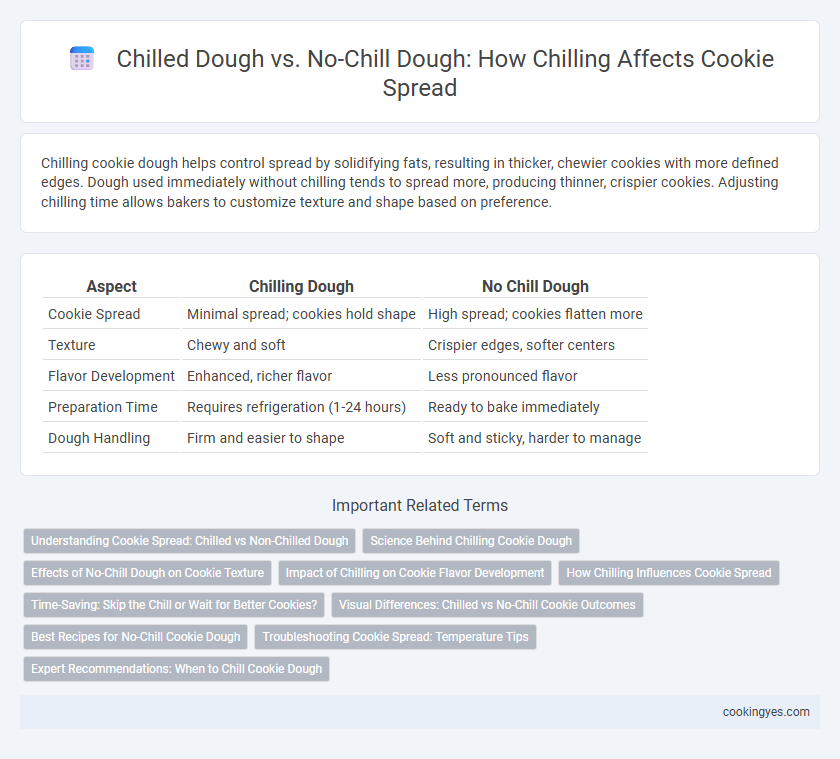Chilling cookie dough helps control spread by solidifying fats, resulting in thicker, chewier cookies with more defined edges. Dough used immediately without chilling tends to spread more, producing thinner, crispier cookies. Adjusting chilling time allows bakers to customize texture and shape based on preference.
Table of Comparison
| Aspect | Chilling Dough | No Chill Dough |
|---|---|---|
| Cookie Spread | Minimal spread; cookies hold shape | High spread; cookies flatten more |
| Texture | Chewy and soft | Crispier edges, softer centers |
| Flavor Development | Enhanced, richer flavor | Less pronounced flavor |
| Preparation Time | Requires refrigeration (1-24 hours) | Ready to bake immediately |
| Dough Handling | Firm and easier to shape | Soft and sticky, harder to manage |
Understanding Cookie Spread: Chilled vs Non-Chilled Dough
Chilled dough reduces cookie spread by solidifying fats, resulting in thicker, chewier cookies while non-chilled dough tends to produce thinner, crispier cookies due to melted fats spreading faster in the oven. The chilling process also allows flour to hydrate fully, enhancing structure and flavor development. Understanding these effects enables bakers to control texture and appearance precisely by adjusting chilling time before baking.
Science Behind Chilling Cookie Dough
Chilling cookie dough slows fat crystallization, allowing gluten strands to relax and sugars to fully hydrate, which creates a thicker, less spread-prone dough. The reduced temperature also solidifies the fats, preventing them from melting too quickly during baking, leading to a thicker, chewier texture. This scientific process controls cookie spread by balancing moisture and fat behavior, resulting in more uniform, structured cookies.
Effects of No-Chill Dough on Cookie Texture
No-chill dough results in cookies with a thinner, crisper texture due to the lack of time for fat solidification and flour hydration, which limits gluten development. This often causes cookies to spread more during baking, leading to a flatter, less structured cookie profile. The absence of chilling reduces moisture redistribution, producing a crunchier bite rather than a chewy, tender center typical of chilled dough cookies.
Impact of Chilling on Cookie Flavor Development
Chilling dough slows yeast and enzyme activity, allowing complex flavor compounds like esters and aldehydes to develop, enhancing the cookie's depth and richness. The cold rest also promotes even butter crystallization, leading to a more controlled spread and a chewy texture with intensified caramel and nutty notes. Without chilling, cookies tend to spread faster during baking and have a simpler, less developed flavor profile due to limited biochemical maturation.
How Chilling Influences Cookie Spread
Chilling dough allows fats to solidify, slowing the melting process during baking and resulting in less cookie spread and thicker texture. Cold dough also enables the flour to fully hydrate, which improves structure and reduces excessive spreading. Conversely, unchilled dough tends to spread more rapidly as warmer fats melt quickly, creating thinner, larger cookies.
Time-Saving: Skip the Chill or Wait for Better Cookies?
Skipping the chill step with no chill dough saves baking time and allows for immediate cookie preparation, ideal for quick cravings or tight schedules. Chilled dough requires several hours but enhances dough consistency, reducing spread and producing thicker, chewier cookies with more controlled shape. Weighing time-saving benefits against texture and appearance is key to choosing between chilling or baking dough instantly.
Visual Differences: Chilled vs No-Chill Cookie Outcomes
Chilling cookie dough significantly reduces spread during baking, resulting in thicker, puffier cookies with more defined edges and a uniform shape. No-chill dough tends to spread more, producing thinner, wider cookies with flatter surfaces and slightly crispier edges. Visual differences are noticeable with chilled cookies appearing more structured, while no-chill cookies develop a rustic, irregular look.
Best Recipes for No-Chill Cookie Dough
No-chill cookie dough saves time by allowing immediate baking without sacrificing flavor or texture, making it ideal for quick cookie spreads. Recipes optimized for no-chill dough often incorporate baking powder or adjust butter temperature to control spread and maintain a soft center. Popular options include classic chocolate chip and snickerdoodle, which yield perfectly chewy cookies without the wait.
Troubleshooting Cookie Spread: Temperature Tips
Chilling dough reduces cookie spread by solidifying fats, preventing excessive melting during baking and resulting in thicker cookies. No chill dough spreads more due to warmer fat consistency, making precise oven temperature control essential to minimize over-spreading. Adjusting baking temperature between 325degF and 350degF can help troubleshoot spread issues by balancing dough consistency and heat exposure.
Expert Recommendations: When to Chill Cookie Dough
Chilling cookie dough solidifies fats, reducing cookie spread and creating thicker, chewier textures preferred by pastry chefs. Expert bakeries recommend chilling dough for at least 30 minutes to several hours to enhance flavor development and control spread, especially for high-butter recipes. No-chill dough often results in thinner, crispier cookies, suitable for quick baking but less optimal for achieving balanced texture and depth.
Chilling Dough vs No Chill Dough for Cookie Spread Infographic

 cookingyes.com
cookingyes.com